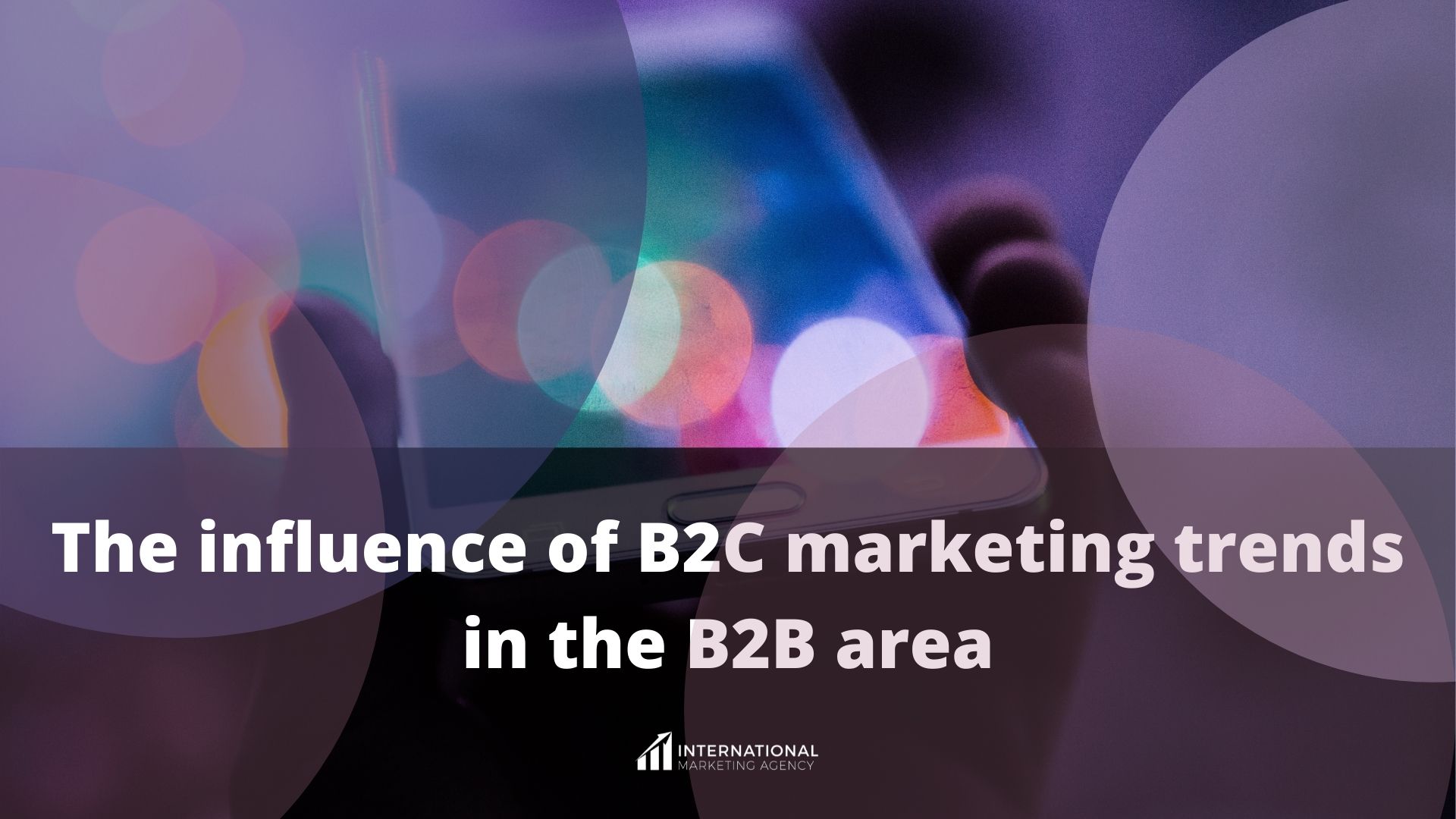The influence of B2C marketing trends in the B2B area

As the line between professional and personal life starts to fade, B2B marketing will feel even more like B2C. When it comes to tech, it’s expected to see B2B companies using tech that was traditionally reserved for personal connections more and more. And relationships that would usually be made at the office or during work hours shift to new spaces online. Before we jump on the marketing trends from B2C that influence the B2B area let’s briefly explain what makes them similar and what makes them different.
What makes B2B and B2C marketing similar?
Here are 4 fundamental points that apply for both categories:
- Human to human marketing
No matter what they are selling a product or service they are still doing marketing for humans.
- Buyer persona
Even though they target different types of buyers they have to identify and develop their buyer persona before they can build out their marketing strategy.
- Sales build on trust
The first and most important thing that they have to do in order to sell something is to build a relationship relayed on trust with their target customers.
- Excellent customer service and experience
In both categories, the goal is the same to provide excellent customer experience and customer service so they can keep the customers by their side.
What makes B2B and B2C marketing different?
Here are 4 points that make them different:
- High price→Low price
B2B prices tend to be higher than B2C prices. B2B buyers need to be well informed in order to make a purchase.
B2C prices are usually lower than B2B prices. Because the prices are lower, customers don’t need a lot of information but as the prices rise, B2C buyers have a higher need to be well informed in order to make a purchase.
- Rational→Emotional
In B2B the messaging is more focused on rational appeal. B2B buyers tend to be more planned and logical with a specific ROI in mind.
In B2C when it comes to the messaging there is more focus on the emotional appeal. B2C buyers tend to be more spontaneous and buy things impulsively.
- Longer sales cycle→Shorter sales cycle
In sales B2B the sales cycle tends to be longer and there is a need to nurture over a long period of time before a sale is made.
In B2C tha sales cycle is shorter than the B2B sales cycle. A sale can be made at the very first touchpoint.
- Educational→Fun
In B2B, customers expect and want to read more educational content that is relevant to them. Industry jargon and business-friendly terms can be used.
In B2C, customers want to read funny content in which they can enjoy and relax their mind. Use of jargon is not preferred.
Which B2C marketing trends influence the B2B area?
1. Content marketing
In 2021 content marketing is a key for success. It’s implemented in both B2C and B2B marketing strategies. It is important to deliver content in a variety of formats to accommodate customers and prospects preferences and reduce friction. There are brands and companies that have grown massive audiences from scratch in the last 18 months thanks to content marketing. What they did differently, what to do to break through?
- Post data-driven content
As content strategy evolves creating data-driven content is going to take the throne. With a wealth of data content creators are able to follow their instincts and say whether doing something is worth it. Customers and prospects want to read superior content that will inform and educate them. Content should help buyers make better informed decisions, while demonstrating true expertise and building authority.
- Put your creativity in content creation
If you want to pop up from the crowd, start creating creative and unique content. Content that it’s not usually seen and will keep your audience’s attention. What kind of content is considered as creative? Let’s start from the one that we all know VIDEO. You can create your content in the form of a video which will be more interesting to your audience. A research made in August 2020 shows that 27.2% of worldwide viewers watched more than 10 hours of online videos on a weekly basis. Another popular creative content it’s STORYTELLING. You can talk about characters with real problems and scenarios in a structured way with beginning, middle and ending. That way you get your audience to empathize with those characters and connect with your brand.
- Create engaging content
It’s crucial for your success to engage with your customers and target audience how they want to be engaged with. But, how can you make your content interactive? Well you can do it by encouraging your customers and target audience to share your post on social media, you can create interesting quizzes from which you learn about your audience, film videos and implement interactive infographics. Another popular type of interactive content are polls and surveys. Polls are often used by businesses on LinkedIn and Instagram. Also you can create ebooks and send emails with engaging content. Just engage.
2.Voice marketing
Voice devices were originally created to be used for making grocery store lists and taking notes. Now you might find voice assistants at home, in a car, on smart TVs, appliances and more. People are using voice search to play songs, ask questions, get directions, turn up the temperature or to open a specific document. It slowly starts to play a huge role in the marketing world since 47% of the online searches are voice searches. Voice search is expected to reach 6.4 billion in the year 2022.
Marketers see great potential in this tool as it gives more information about consumers and their needs. It is extremely important to make your business ready to compete on the market and use this advanced technology tool.
3.Data driven decision making (DDDM)
Every business today aims to be data-driven.
Namely, due to modern times, data driven decision making has a key role in running a business. Nowadays, this type of decision-making method is used in more and more types of businesses such as manufacturing industries, health care medicine, education, ecommerce, etc.
The first question that arises – what is data driven decision making?
Data driven decision making – DDDM means use of carefully selected information, facts, and measures when making business decisions that correlate with the goals of a company. It is the opposite from making an intuitive decision and a decision that is based on observation alone.
Now that we have understood the definition of data-driven decision making it is important to understand what this method means for a business?
Businesses are using data in order to make better decisions. No matter which sector in a business it is, whether for sales, marketing, finance, etc., making decisions based on previously well-processed information and facts is crucial and quite important for the good operation of the business.
Harvard Business Review in one of its publications analyzed that businesses that use this method of decision making are 5% more productive and 6% more profitable than their competitors.
Of course, it is important to determine what data to use for a particular situation.
Not every data is as important as any other data. Careful use of selected data can lead to success.
Netflix has started as a mail-based DVD sharing business. With the data-driven decision making it became an internet streaming. Well, Netflix without its data would still be mailing outdated movie content.
Amazon is the second well known example. At the beginning Amazon was an online bookstore and afterwards it became a giant online platform on which products of all types can be found. Of course, the well-sorted data is the one responsible for the success of Amazon.
Becoming a data-driven business is difficult at the beginning, but it is definitely a completely worthy process.

4.Customer experience management (CXM)
Let’s take a walk in our customers’ shoes!
What is customer experience management?
Customer experience management is a database about the behavior of users, their habits, and their overall action viewed through the prism of cooperation with a particular brand or business.
What does it look like in practice?
Let’s imagine an online store which offers the purchase of products on the website of the business and also offers a mobile application for the purchase of products. The customer experience management allows the business to identify the products which are already bought by a particular customer and remove them from the foreground of the offer for that particular customer.
The marketing campaign would be completely unsuccessful if we offer a potential customer the products he or she has already bought. Based on the analysis made, we should offer similar products to that customer – a product that would complement a whole set of products, for example.
The performance of customer experience management has the key role whether your business succeeds or fails. Customer’s behaviors and preferences are changing rapidly, consequently businesses should be able to keep up with those changes and act quickly in order to optimize customer satisfaction and loyalty. This can’t be done without the use of good CXM.
There are a lot of customer experience management strategy tools that can help you improve customer experience, such as:
- Customer surveys (Customer satisfaction (CSAT) surveys Net Promoter Score® (NPS®) surveys, Customer Effort Score (CES) surveys, User experience surveys, Product satisfaction surveys and Marketing surveys)
- Customer profiles – Creating detailed customer profiles. You need an appropriate tool that will help you collect, analyze, and act on that data.
- Integrate your tech stack
Managing your customer experience with the right tool can help your business make magic happen every day. You will create loyal and satisfied customers. This will really help your business grow.
Customer experience management is a complex matter. This type of management consists of many pieces which, if properly set up and used, will surely lead to customer’s satisfaction, loyalty, and turning them into advocates.
5.Omni – channel marketing strategy
There were times when customers made purchases in brick-and-mortar stores and with time the customer’s journey has changed. The needs of the consumers have changed. Today, it is of particular importance that businesses make the purchasing process as smooth as possible in order to avoid customer’s frustration.
There is often confusion. Yes, businesses have a website, a blog, and various social media accounts. However, these types of channels are being used separately, but it is important to note that if these channels don’t work together, it’s not an omni-channel approach.
Namely, omni-channel marketing means that everything comes together, more precisely, all of the marketing efforts are integrated to create a unified strategy for the brand advertising strategy.
This type of strategy means that the customers are able to reach out a printed catalogue for example, both through their smartphone and in person, without losing sight of your brand identity. In other words, the customer should be able to move from online shopping to shopping in person without any hassle. The story behind this type of marketing strategy is to make it universal no matter which channel the customer accesses from.
It is more than clear that omni channel marketing strategy has benefits both for businesses and for customers. In accordance with a performed analysis, 74% of retailers have already started using omnichannel strategy or they have already implemented it, 67% of customers are using multiple channels in order to complete their transaction and 40% of the customers have stated that if they can’t choose their preferred channel, they won’t finish the purchase.
The main questions are what is the use and what is the benefit from omni channel marketing strategy?
Omni channel marketing strategy drives sales, increases revenues, and improves engagement. In numbers, performed research shows that omni-channel campaigns earn 19% engagement and single channel campaigns earn 5.4% engagement.
And now that we have stated what is an omni-channel marketing strategy and how it can improve the customer experience, let’s state some directions on how it can be used in the business.
Here are some tips for omnichannel strategy which will bring outstanding results:
- Businesses need to first figure out what channel is being used by their customers. Why? Because if you use all of your efforts on social media channels and ignore email communication, a channel that is being used by the customer, you won’t have the best results.
- Then, businesses need to focus on creating buyer personas and personalized strategy. Why? Because this way you create content that engages your target audience.
- Businesses need to invest more in consumer insights and alco to collect and then analyze data in order to find brand advocates. Why? Because if you look for trends you will figure out what your ideal customers are looking for.
- Businesses need to be consistent. Why? Because this way you set expectations for future interactions, build customer confidence, earn customers’ trust and build credibility for the business.
Implementing an omnichannel strategy is not so simple, but when it’s done properly it offers a lot of benefits, so start today!
6.Paid marketing
We all know the importance of organic search. In fact, online success begins with organic search. However, in order to make content more discoverable on search engines such as Google and Bing, paid advertising is a big must for your content boost.When you do paid marketing your content gets featured highly at the top of search results pages and in that way the likelihood of more views and clicks is increasing.
While B2C companies primarily rely on brand-name searches and variations in the generic terms of the items or services they sell to reach customers, B2Bs’ generally know exactly what they are looking for but have a longer sales process. For instance, for B2B companies it takes so much time and effort to research a supplier or provider, but once a purchase decision is passed they will likely continue to make the same decision over and over again for years to come.
Investment in video content
No matter if you do B2B or B2C marketing or sales you need to keep your audience engaged in a manner that will be subtle enough to become an appropriate marketing tool. You probably figured that one of those ways is creating and sharing video content.
What makes this the right tool and why is it becoming the number one choice for both B2B and B2C? Simply, it’s the coverage, no matter the location across the globe, everyone can access and watch a video on their mobile or desktop device.
As video may traditionally be seen as an appropriate marketing tool for B2C businesses, somehow more and more B2B companies are realizing the value added from a video.
Statistics have it that 33% of people’s time on the internet is spent on watching videos. When we add that even in B2B, business is not made by companies, but by human factors in those companies, then we get to realize the importance behind these statistics.
The B2B is accepting the increased use of video. It is set to continue, and businesses, especially in the B2B space, need to maximize this advantage. Creating content that is helpful and in high quality should be your top priority, but missing on using video is no longer an option.
7.Partnership and relationship
As I have mentioned earlier even business is not made by companies but by human factors therein. You can distinguish between B2B vs. B2C marketing, but in the end you can’t distinguish when that narrows down to H2H i.e. Human 2 Human.
No matter whether a person that has a specific role in a company deals with other companies (B2B) or goes on a shopping spree and buys new tennis shoes for tennis lessons (B2C), wants to be approached as a person.
This leads to the importance of building relationships in both B2C and B2B.
We all know that when it comes to sales, people buy with emotion and then justify that emotion with logic. But when it comes to B2B people first follow logic but then again apply emotion to justify the logic. What is relevant here is although building
relationships start in B2C marketing, it is very important for sustainable B2B. For B2B if you don’t nurture your contacts or create partnerships in the network they will not sustain.
Even when proper automatization for B2B is applied, if there is no personalization and building relationship content in behind, you can’t expect proper engagement.

Conclusion
When it comes to influence and strategies, B2C and B2B marketers follow the same rules, but in a kind of different manner.
When it comes to applying these influences or strategies, B2B marketers should invest in tactics that address their unique needs.
Although, we must admit that many B2B marketers don’t have as much freedom to operate as B2C marketers do, but should choose a way that will result in elevating the process that grows businesses.
So what do you think , who is setting the trends here? The one that is establishing them in an area where individuals decide or the one that is establishing them in a more complex structure where a lot of decision makers are involved?


